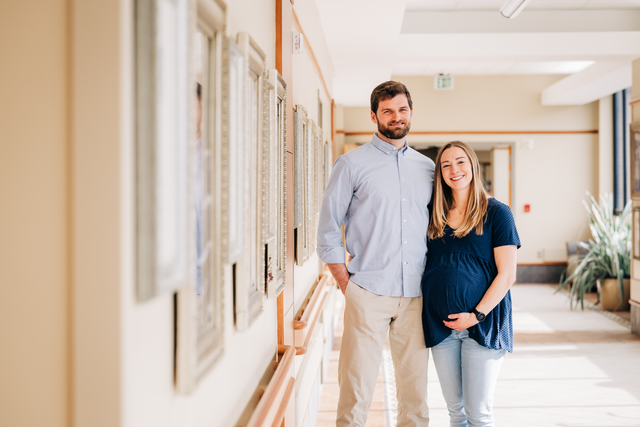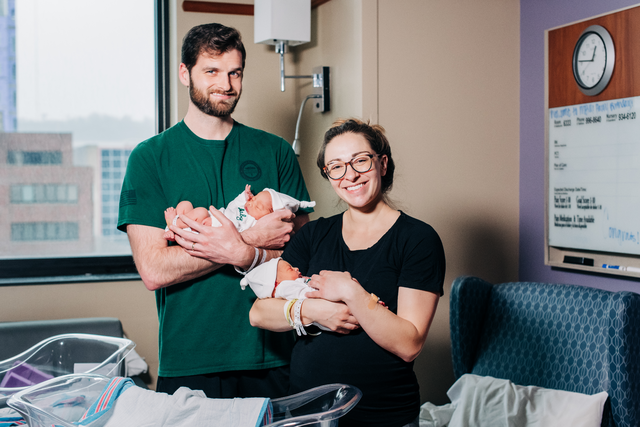
Photography: Andrea Mabry
Shellie Pascoe’s phone started lighting up with messages from family and friends all sharing the same story. A patient at the University of Alabama at Birmingham Hospital had a one-in-a-million pregnancy: She had a double uterus and was pregnant with a baby in each.
Shellie also had a double uterus, was pregnant with a baby in each and was a patient at UAB Hospital. The catch? The story making national headlines was not about her; it was about another Alabama woman, Kelsey Hatcher.
“To say we were shocked is an understatement,” Shellie said. “We knew how rare my pregnancy was and did not expect to find someone else in the same position, let alone at the same hospital.”
Double the surprise
To rewind several months prior, Shellie waited with bated breath as the ultrasound technician began her scan. After two miscarriages within the past year and a half, Shellie and her husband, John, were cautiously optimistic they would walk out of the seven-week appointment with signs of a healthy and growing baby.
Instead, they received a surprise of a lifetime: Shellie was pregnant with two babies, one in each uterus. The pregnancy, known as a dicavitary pregnancy, is an estimated one-in-a-million pregnancy in women with a double uterus.

Photography: Jennifer Alsabrook-Turner
Shellie discovered she had a double uterus, or uterus didelphys, after her first miscarriage. The rare congenital anomaly occurs when the Müllerian ducts fail to fuse together and subsequently form two uterine cavities. Each uterus has one fallopian tube and one ovary. It occurs in 0.3 percent of women.
“When we found out about my condition, we were informed about the higher risk of pregnancy complications and potential fertility issues,” Shellie said. “I had a second miscarriage not long after the diagnosis. By the time I got pregnant again, we were extremely nervous that we would have another loss.”
Shellie, who is a physical therapist in the United States Army and stationed at Fort Novosel, was immediately referred to UAB to visit a maternal-fetal medicine physician who specializes in high-risk and rare pregnancies.
“I have cared for several women with a double uterus; however, the only time I’d heard of someone with a baby in each uterus was on a television show,” said Brian Brocato, D.O., associate professor in the Division of Maternal-Fetal Medicine. “We see high-risk and unique pregnancies daily, but I knew Shellie’s case was on a whole new level.”
Brocato worked closely with the local obstetrician to co-manage Shellie’s pregnancy, with her and John making the three-and-a-half-hour trek to Birmingham every four weeks. While the pregnancy progressed in a typical fashion, one question loomed — how and when to deliver the babies.
Special connections
Brocato turned to his maternal-fetal medicine colleagues for help on this case. No one else on the team had incurred this type of pregnancy, or so he thought.
“Our team frequently collaborates internally on unique cases like Shellie’s,” Brocato said. “We soon realized we had two patients with the same once-in-a-lifetime pregnancy.”

Photography: Andrea Mabry
Kelsey, who had had three previous pregnancies, was two months ahead of Shellie. The two pregnancies had slight differences, but Brocato was excited to have another case to learn from and colleagues to lean on for advice.
While Shellie and Kelsey lived roughly four hours apart, UAB was not their only connection. A member of Shellie’s church and a member of Kelsey’s church were related and helped connect the two.
“It is scary going through two losses and then finding out I have a rare condition and pregnancy,” Shellie said. “Connecting with Kelsey, being able to follow her journey and seeing her babies come out healthy provided us hope. It was also comforting to know that the UAB team was going to have a hands-on experience to learn from.”
Delivery day
While Kelsey delivered one baby vaginally and the other via c-section, Shellie and her care team opted for a scheduled cesarean section at 39 weeks. Brocato says the decision was primarily because Shellie had never delivered a baby vaginally prior to this pregnancy.

Photography: Andrea Mabry
On March 6, 2024, Kaylee and Kamden Pascoe were delivered at the UAB Women and Infants Center.
“We had some concerns about making two internal incisions due to potential blood loss,” Brocato said. “Thankfully, the babies were positioned to where we could get both out with one larger incision. Kaylee, who was in the right uterus, came out first, followed by Kamden only two minutes later.”
Three days and some rest later, Shellie and John packed up their minivan to make the journey back to Dothan, this time as a family of four.
“We knew our journey to have children would not be without challenges, but it made being able to finally take Kaylee and Kamden home that much richer,” John said. “We hope our journey will be a source of encouragement to others in the same way the UAB team and Kelsey were to us.”
What are the odds?
Two women with different backgrounds and journeys, living hours apart, both with a one-in-a-million pregnancy at the same time: It may be too rare to calculate, Brocato says.
But for both Alabama residents to end up at UAB: Not as rare as one would think.
“UAB is an academic research and referral center, so we see patients every day from all over the state and the South,” Brocato said. “Our interdisciplinary team with maternal-fetal medicine specialists, nurses, neonatologists and obstetric anesthesiologists allows us to take on challenging cases like Kelsey’s and Shellie’s where there is scarce literature or best practices to follow.”
